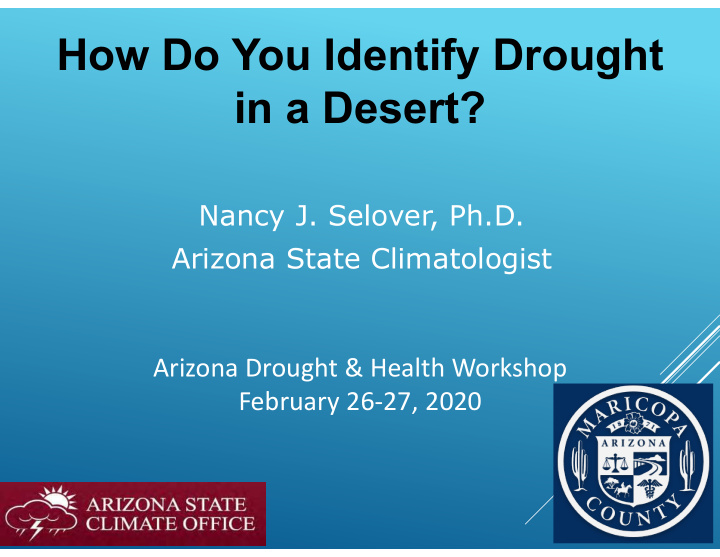



How Do You Identify Drought in a Desert? Nancy J. Selover, Ph.D. Arizona State Climatologist Arizona Drought & Health Workshop February 26-27, 2020
Desert vs Drought Desert: Normal condition is less precipitation than evaporation on an annual basis.
Rainfall +3.62” Evaporation -58.15” Net -54.53” Rainfall +52.59” Evaporation -23.48” Net +29.11”
Desert vs Drought Desert: Normal condition is less precipitation than evaporation on an annual basis. Drought: Drier than normal conditions. Can have Hydrologic impacts, Agricultural impacts, Ecological impacts or Socio-economic impacts In wet regions, like the East Coast or the Gulf Coast, this could be a week without rain. In dry regions, like the Western U.S., this would be consecutive years without rain – a cumulative effect.
Rainfall +3.62” Evaporation -58.15” Net -54.53” Rainfall +52.59” Evaporation -23.48” Net +29.11”
Short-term Drought vs Long-term Drought Short-term Drought: A drier than normal season that results in significantly reduced vegetation growth – rangeland grass, forage, crops. Or an unusually dry spring or summer that results in dead vegetation and increased brushfire risk. Long-term Drought: Consecutive dry years resulting in reduced water resources. Low streamflow, low reservoir levels, stressed forests that can lead to major forest fires.
When does it start and when does it end? Droughts are slow moving disasters that we rarely recognize until after they have taken hold. We usually have to look back to determine when a drought started. Droughts have no set length or cycle. The next rainstorm or snowstorm may not signify the end of the drought. Timing is critical – did the rain come at the right time?
Impacts are everything . Who is affected and how are they affected? Rangeland, Wildlife, Livestock, Crops, Streamflow, Riparian Systems, Aquifers, Water Supplies
Droughts have Secondary Impacts Stressed Poor Water Flash Forests Wildfires Quality Flooding Poor Air Dust Dry Quality Supplemental Storms Rangeland Feed Economic Overpumping Losses in Reduced Land Groundwater Water Subsidence/ All Sectors Supply Hauling sinkholes Water Wells Dry Lakes & Running Dry Stockponds Loss of Recreation
How Do We Detect a Drought? There are many Drought Indices. Here are a few: • Palmer Drought Severity Index (PDSI), relative dryness based on • temperature & precipitation Variations include Palmer Hydrological Drought Index, • Palmer Modified Drought Index, Palmer Z-Index – similar but at different time scales. Standardized Precipitation Index (SPI) based on precipitation • ranking – works at many times scales Standardized Precipitation Evaporative Index (SPEI) based on • precipitation and evaporation – works better in the western US. Evaporative Demand Drought Index (EDDI) a measure of how • anomalous the atmospheric evaporative demand is for a location over a time period 1-week to 12-month. Crop Moisture Index (CMI) based on weekly temperature & • precipitation. Surface Water Supply Index (SWSI) based on prediction of • available surface water within a watershed. Vegetation Drought Response Index (VegDRI) separates drought • stress from other vegetation stressors.
Impacts Vary by State https://droughtmonitor.unl.edu/About/WhatistheUSDM.aspx
Historical Precipitation – Statewide Averages 13/16 Wet 3/16 Dry 29/37 Dry 23/37 Wet 8/37 Wet 14/37 Dry 10/10 18/25 Dry Dry 7/25 Wet Dry and Wet Periods 1895-2019
Winter Precipitation % Average Colorado River Basin WY 2012 WY 2014 WY 2013 WY 2016 WY 2017 WY 2015
Precipitation % of Average Winter 2018, 2019, 2020 (so far)
Arizona Long-Term Drought Status October 2018 December 2018 June 2019 April 2019 Based on average of 24-, 36-, and 48- month SPI & SPEI
Drought in Arizona since 2000 Drought Monitor map produced weekly by the National Drought Mitigation Center is used by USDA to identify counties that need drought relief in the form of agricultural assistance – including Livestock Forage Program, and economic relief from crop failure.
WILLIAMS DECLARES WATER CRISIS ARIZONA DAILY SUN MARCH 5, 2014 22 OffTheGridNews May 17, 2014
Bark Beetle Infestation - 2018 Source: Arizona Forest Health Conditions 2018, AZ. Dept of Forestry and Fire Management
2018 – Bark Beetle infestation map. Increase in acres affected by Bark Beetles from 2017 to 2018 was 3,141% Source: Arizona Forest Health Conditions 2018, AZ. Dept of Forestry and Fire Management
Mt. Bigelow 25
Rodeo-Chediski 2002 468,638 acres burned The Rodeo-Chediski Fire burns across the Mogollon Rim. The massive 2002 blaze burned 468,638 acres. USDA, Apache-Sitgreaves NF http://www.srpnet.com/water/forest/involvement.aspx
Wallow Fire - 2011 ~538,049 acres, 841 sq. mi. Kari Greer/U. S. Forest Service 27
Number of Large Wildfires in Western Regions from 1984-2011 Climate Science Special Report: Fourth National Climate Assessment
Annual Number of Acres Burned in Wildland Fires, 1980-2018
Chemistry of Wildfires Primary air pollutants � Particulate Matter (PM) • CO • NO 2 • Polycyclic aromatic hydrocarbons (PAHs) • Volatile organic compounds (VOCs) • Secondary air pollutants � Particulate Matter (PM) • Ozone • � When vehicles and buildings burn: Structural fire smoke contains other toxic air contaminants • • HCN, HCl, phosgene, metals • toluene, styrene, dioxins Presentation Wildfires & Health Kari Nadeau, Ph.D. M.D. Stanford Medicine http://med.stanford.edu/wildfire-and-health-Presentation-Kari- 2.17.19rev.pptx 31
Floodwaters gather at the Schultz Fire site. Estimates put the damage caused by the fire and subsequent flooding at $147 million. Ecological Restoration Institute, NAU http://www.srpnet.com/water/forest/involvement.aspx
Post-Fire Burn Scar Health Effects: High fire temperatures force hydrophobic substances into the soil essentially sealing it from absorbing water. Run-off after rainfall becomes overland flow, causing significant flooding downstream of the fire. Debris from the burn is also washed downstream into the washes, streams, and reservoirs, leading to water quality issues. Ponding of water that does not infiltrate leads to increased populations of potentially disease carrying mosquitos.
July 5, 2011 Major Dust Storm 50 mph winds, ~100 miles wide, 5000-6000 feet high, traveled 150 miles from Tucson past Wickenburg http://www.wrh.noaa.gov/psr/pns/2011/July/DustStorm.php
Highway Dust Storms
Arizona Water Sources
Overpumping Groundwater – prevalent in East Valley
QUESTIONS? selover@asu.edu 480-965-0580
Recommend
More recommend